Author: Ronen Shekel
In a previous post, we talked about how periodic poling provides quasi-phase-matching, its various benefits, and the control it provides over different SPDC parameters.
SPDC light is used for numerous applications, such as quantum imaging, quantum communications, and quantum computing. As these applications mature, it becomes increasingly important to have better and stronger control over the properties of the generated quantum states, such as their purity and fidelity. For instance, for some quantum computation or communication applications one would like to generate specific entangled states, such as Bell states or cluster states [1]. However, for a heralded single-photon application, one would like the SPDC process to result in a separable state, since heralding a photon out of an entangled pair will result in a single photon in a mixed state.
A promising approach for achieving such control is to create more sophisticated crystals by further tailoring their poling and realizing aperiodic poling and custom duty cycles. For example, one could create a chirping grating, where the poling interval is linearly varied between the entrance and end facets of the crystal. Such a method has been employed for the generation of an ultrabroad-spectrum in SPDC light [2], achieving a record-breaking narrow Hong-Ou-Mandel (HOM) dip.
Another example of engineering poling is given in [3, 4]. In the usual case, the nonlinearity that the pump pulse experiences is turned on suddenly as the pump enters the crystal and turned off just as suddenly as the pump exits the crystal. This results in sinc side lobes in the joint spectrum amplitude (JSA) of the generated states. What it means is that part of the SPDC photon pairs are generated at a combination of different wavelengths, resulting in different quantum states. Since for high visibility quantum interference and superposition we need photons which are well defined in their physical properties, we need to find an engineering method which will concentrate the generated SPDC photon pairs into one well defined quantum state. Here, it is shown that a special type of domain engineering allows an apodization of the spectrum, the removal of the sinc sidelobes (Fig. 1).
As evident by the large HOM dip visibility, the states generated from this apodised crystal are highly pure and indistinguishable. Such purity and indistinguishability are of utmost importance for advanced photonic technologies, which rely on a high number of successive two-photon interference events.
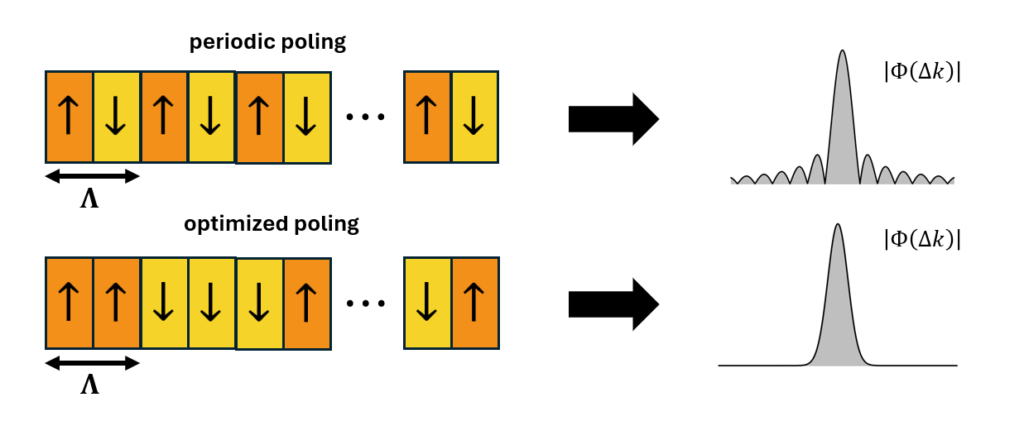
Having control on the crystal spectral properties is of special interest when generating high-dimensional quantum states and novel entanglement possibilities [6] . Such states are gaining growing interest in recent years due to their higher information capacity and their improved resilience to noise [5]. They come in two flavors: spectral entanglement and spatial entanglement. As opposed to polarization encoding, both cases allow the encoding of high-dimensional information, enabling each photon to carry more information. Encoding in the spectrum enjoys the fact that such states experience virtually no decoherence. Encoding in the spatial domain is attractive because it is easy to control and manipulate using the mature technology of spatial light modulators. In both cases, aperiodic polling, together with optimizing the pump beam that stimulates the SPDC process, has been shown to allow greater control over the generated states.
In [6], a variety of spectrally encoded states, such as Bell states and two-qutrit states, have been generated using domain engineering, along with the modulation of a broadband pulsed pump. Using this method, there is no need to filter the (very few) SPDC photons after the generation process, since shaping the pump and crystal already enables the generation of the desired joint spectrum directly. Specifically, the pump modulation was done via a simple technique, using only passive optical elements such as birefringent wedges and waveplates. In general, the pump spectrum could be shaped even more flexibly using diffraction gratings and spatial light modulators [7].
A similar two-dimensional approach is shown in [8], but in the spatial domain. A detailed physical model, together with a machine learning framework, finds optimal 3-dimensional crystal structures as well as tailored pump shapes that generate arbitrary spatially encoded states. In [9] this has been shown experimentally, generating a spatial Bell state in the Hermite-Gauss basis, by engineering the nonlinear crystal.
Raicol is a world leader in both periodic and aperiodic poling of nonlinear crystals, and provides aperiodically poled KTP crystals (APKTP) that increase the spectral purity and indistinguishability of the emitted photon pairs at telecom wavelengths. We also provide tailored solutions for crystals with aperiodic poling. Please contact us to discuss your application and how we can help you use state-of-the-art crystals to achieve your goals.
[1] Briegel, Hans J., et al. “Measurement-based quantum computation.” Nature Physics 5.1 (2009): 19-26.
[2] Nasr, M.B., Carrasco, S., Saleh, B.E., Sergienko, A.V., Teich, M.C., Torres, J.P., Torner, L., Hum, D.S. and Fejer, M.M., 2008. Ultrabroadband biphotons generated via chirped quasi-phase-matched optical parametric down-conversion. Physical review letters, 100(18), p.183601.
[3] Graffitti, F., Barrow, P., Proietti, M., Kundys, D. and Fedrizzi, A., 2018. Independent high-purity photons created in domain-engineered crystals. Optica, 5(5), pp.514-517.
[4] Dosseva, Annamaria, Łukasz Cincio, and Agata M. Brańczyk. “Shaping the joint spectrum of down-converted photons through optimized custom poling.” Physical Review A 93.1 (2016): 013801.
[5] Ecker, Sebastian, Frédéric Bouchard, Lukas Bulla, Florian Brandt, Oskar Kohout, Fabian Steinlechner, Robert Fickler et al. “Overcoming noise in entanglement distribution.” Physical Review X 9, no. 4 (2019): 041042.
[6] Shukhin, Anatoly, Inbar Hurvitz, Sivan Trajtenberg-Mills, Ady Arie, and Hagai Eisenberg. “Two-dimensional control of a biphoton joint spectrum.” Optics Express 32, no. 6 (2024): 10158-10174.
[7] Ansari, Vahid, et al. “Heralded generation of high-purity ultrashort single photons in programmable temporal shapes.” Optics express 26.3 (2018): 2764-2774.
[8] Rozenberg, Eyal, Aviv Karnieli, Ofir Yesharim, Joshua Foley-Comer, Sivan Trajtenberg-Mills, Daniel Freedman, Alex M. Bronstein, and Ady Arie. “Inverse design of spontaneous parametric downconversion for generation of high-dimensional qudits.” Optica 9, no. 6 (2022): 602-615.
[9] Yesharim, Ofir, Shaul Pearl, Joshua Foley-Comer, Irit Juwiler, and Ady Arie. “Direct generation of spatially entangled qudits using quantum nonlinear optical holography.” Science Advances 9, no. 8 (2023): eade7968.
Have you already subscribed to our YouTube channel? Don’t miss out—subscribe now for exclusive content and updates from our company.
Home » Archives for Keren
Author: Ronen Shekel
The generation of pure nonclassical states of light is one of the most important goals of optical quantum information science. A popular and versatile source for creating such states is spontaneous parametric down-conversion (SPDC) – a nonlinear process where a pump beam hits a nonlinear crystal and produces pairs of lower energy photons [1]. Indeed, in the past several decades, SPDC has been widely used for generating heralded single photons and entangled photon pairs, used for applications such as quantum communications and quantum metrology.
For the SPDC process to be efficient, both energy and momentum must be conserved, as depicted in Fig. 1a. In an ideal scenario without chromatic dispersion, phase matching would work trivially, since the frequency and wavevector are simply related by a factor of the speed of light. However, real optical materials exhibit chromatic dispersion, which means that the refractive index varies with wavelength, resulting in a wavevector mismatch Δk_z.
One way to overcome the wavevector mismatch, named birefringent phase matching [2], is by taking advantage of the difference in phase accumulation for different polarizations. In this technique, the polarization of the pump and generated photons are chosen such that this effect will compensate for the chromatic dispersion.
A second popular technique, named quasi-phase matching, was proposed as early as 1962 [3]. This technique resolves the mismatch by splitting the crystal into domains, where alternating domains have nonlinear coefficients of opposite signs (Fig. 1b). This technique may be understood using a phasor diagram (Fig. 1c). The wavevector mismatch causes the phases to accumulate differently, and after a finite propagation distance, they will begin to interfere destructively. With quasi-phase matching, the domain periodicity Λ is chosen such that when the process reaches the destructive interference region, the sign of the phasors are flipped, and the process is allowed to continue to build constructively.

Interestingly, it took until the mid-1980s for this technique to become widespread experimentally [4], using periodic polling. This is because the creation of such domains is challenging, and typically uses ferroelectric domain engineering [5]. This involves the application of a strong electric field to a ferroelectric crystal via patterned electrodes on the crystal surface. This strong field changes the crystal orientation under the electrodes and thus reverses the sign of its nonlinear coefficient. Periodic poling is especially challenging to perform on large-aperture crystals and with small poling periods.
The advantages of quasi-phase matching are that it allows the use of materials with stronger nonlinear coefficients, avoids spatial walk-off, and does not add requirements on the polarization of the different fields. Another advantage is that by tailoring the poling period, different SPDC parameters may be controlled.
For example, as has been shown in [6], using different poling periods could determine whether a type-0 or type-II process will take place. A Type-0 process, where the pump and both generated photons have the same polarization, could be desirable due to its high pair-generation rate. However, it is relatively sensitive to temperature changes and has a large bandwidth. In a type-II process, the two resulting photons have orthogonal polarization, and a narrow spectrum, but the process tends to be weaker.
It is very important to understand the specific application and desired figure of merit before choosing a crystal configuration. For instance, is the total flux the important measure? Or perhaps the total flux per nm of wavelength? Is spatial entanglement a desired feature or something to avoid? Depending on the exact application, a different configuration of pump beam, crystal dimensions, temperature, and poling periodicity may be the best fit [7].
Raicol Crystals is a world-leader in quasi phase matched crystals, and provides periodically poled nonlinear crystals such as PPLN, PPKTP, and PPSLT, allowing a wide range of periodicities and crystal dimensions. Please contact us for further details! We also provide aperiodically poled KTP (APKTP) crystals, which allow even further control of the resulting quantum state. This will be the subject of another post, so stay tuned!
[1] Walborn, S.P., Monken, C.H., Pádua, S. and Ribeiro, P.S., 2010. Spatial correlations in parametric down-conversion. Physics Reports, 495(4-5), pp.87-139.
[2] Boyd, R.W., Gaeta, A.L. and Giese, E., 2008. Nonlinear optics.
[3] Armstrong, J. A., N. Bloembergen, J. Ducuing, and Peter S. Pershan. “Interactions between light waves in a nonlinear dielectric.” Physical review 127, no. 6 (1962): 1918.
[4] R. Paschotta, article on “Quasi-phase Matching” in the RP Photonics Encyclopedia, retrieved 2024-08-21, https://doi.org/10.61835/kj9
[5] Yamada, M., Nada, N., Saitoh, M. and Watanabe, K., 1993. First‐order quasi‐phase matched LiNbO3 waveguide periodically poled by applying an external field for efficient blue second‐harmonic generation. Applied Physics Letters, 62(5), pp.435-436.
[6] Steinlechner, F., Gilaberte, M., Jofre, M., Scheidl, T., Torres, J.P., Pruneri, V. and Ursin, R., 2014. Efficient heralding of polarization-entangled photons from type-0 and type-II spontaneous parametric downconversion in periodically poled KTiOPO 4. JOSA B, 31(9), pp.2068-2076.
[7] Schneeloch, J., Knarr, S.H., Bogorin, D.F., Levangie, M.L., Tison, C.C., Frank, R., Howland, G.A., Fanto, M.L. and Alsing, P.M., 2019. Introduction to the absolute brightness and number statistics in spontaneous parametric down-conversion. Journal of Optics, 21(4), p.043501.
Have you already subscribed to our YouTube channel? Don’t miss out—subscribe now for exclusive content and updates.
Author: Ronen Shekel
One of the most remarkable features of quantum theory is entanglement, where quantum systems show nonlocal correlations between particles or photons that are impossible to explain using classical physics. This can famously be demonstrated, for example, by violating a Bell inequality [1, 2]. While in many cases entanglement between two-level systems (qubits) is discussed, high-dimensional entanglement between multi-level systems provides an even richer structure.
High-dimensional entangled states are attractive because they have a greater information capacity, and also show increased resistance to noise and losses [3]. Additionally, it is relatively straightforward to generate high-dimensional entangled states using spontaneous parametric down-conversion (SPDC), and to shape them using liquid crystal spatial light modulators [4].
In SPDC [5], a strong plane-wave pump beam impinges upon a nonlinear crystal such as PPKTP (Periodic polled KTP). With some probability, related to the crystal’s nonlinear coefficients, a pump photon will be annihilated, and two entangled photons will be created (Fig. 1a). Since energy must be conserved, the frequencies of these two photons must sum to that of the pump photon, and here we will assume the degenerate case, where they have the same frequency (Fig. 1b). Since momentum must be conserved, the wave vectors of the created photons must add up to that of the pump photon, which is pointing in a specific direction, since the pump is a plane wave. Consequently, the two photons will have anti-correlations in their transverse momentum (Fig. 1c). This means that if one photon is emitted with a certain angle, its twin will be emitted in the opposite direction with respect to the pump beam.
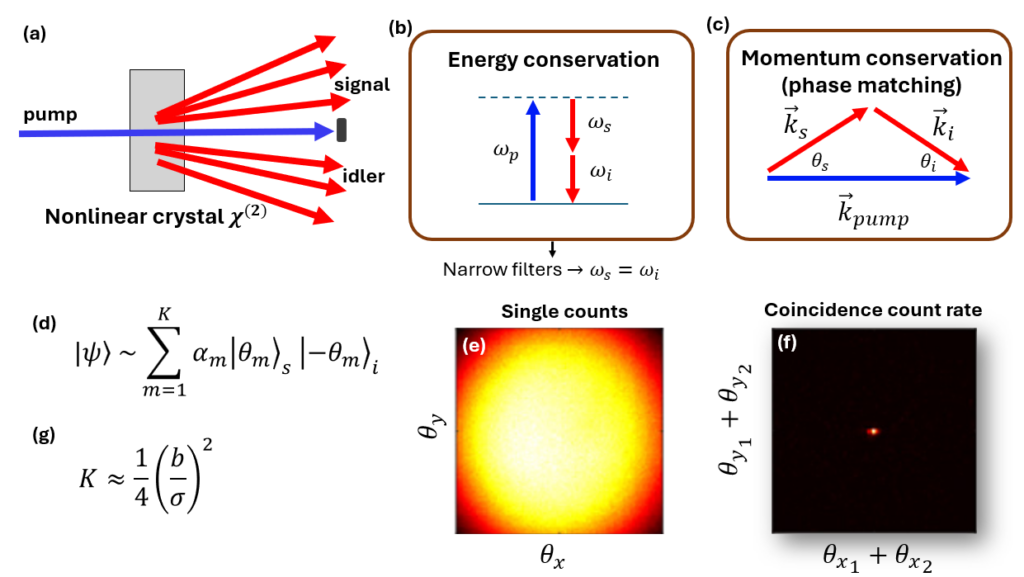
In fact, the generated state of these two photons is a coherent superposition of emission in these different angles, each photon in an opposite direction, with coefficients that depend on the exact phase-matching conditions (Fig. 1d), and typically depend on the angles like a sinc function [5]. These correlations may be measured in the far-field. Using a simple camera, we observe the “single counts”, which is the average intensity of photons emitted in all the directions permitted by the phase matching, which may be a rather wide region (Fig. 1e). Performing coincidence measurements, however, will reveal that given that one photon was measured in a certain angle, the twin photon will always be strongly correlated, and will be found in a much smaller “coincidence region” (Fig. 1f).
The ratio between the coincidence region and the single counts region quantifies the number of distinct modes in the quantum superposition, which is related to its Schmidt rank [6, 7] (Fig. 1g). Hence, to tailor the spatial entanglement properties in SPDC, one should consider both the width of the phase matching function (controlling the single counts region) and the strength of the correlations, and plan an optical setup accordingly.
Specifically, the angular width b of the phase matching sinc function, or equivalently, the angular range allowed by the SPDC process, is determined by the pump wavelength λ_p, and by the crystal thickness L, and is approximately. √(λ_p/L) Thus, while using a thin crystal will result in smaller SPDC flux due to a shorter interaction length, it will typically allow a larger range of emission angles, and will generate highly spatially entangled states.
Conversely, the width of the coincidence region is determined by the angular spectrum of the pump, σ. Indeed, for a plane-wave pump with a single well-defined momentum vector, we expect perfect correlations. However, a finite pump beam will necessarily contain many different angles, which will allow an angle mismatch in the momentum conservation. This is referred to more generally as the transfer of angular spectrum from the pump to the SPDC correlations [8].
In conclusion, having a wide pump beam with a narrow angular spectrum, and using a thin crystal, will increase the dimensionality of the SPDC spatial entanglement. The same reasoning about the number of effective modes can equivalently be carried out in the near-field: A wide pump beam yields a correspondingly large emission area of the SPDC photons, and a thin crystal results in each pair of photons being strongly spatially correlated at the output of the crystal due to the small propagation distance traveled from their point of generation [6, 9].
Of course, one doesn’t always want high-dimensional spatial entanglement. For instance, in many cases, SPDC photons are coupled into single-mode fibers. In such a case, we would like to generate only a single spatial mode to get good coupling to the fiber. A good rule of thumb for this is to set the Rayleigh length of the pump to be the length of the crystal.
At Raicol, we provide a variety of nonlinear crystals with a rich range of parameters, allowing you to design your optical setup exactly for your needs. We also provide custom-made periodic polled crystals with specially tailored polling, allowing the shaping of the two-photon joint spectral intensity [10], which will be the subject of a different post. For more information, please visit our products page, and contact us if you have any questions.
[1] Bell, John S. “On the einstein podolsky rosen paradox.” Physics Physique Fizika 1, no. 3 (1964): 195.
[2] Brunner, Nicolas, Daniel Cavalcanti, Stefano Pironio, Valerio Scarani, and Stephanie Wehner. “Bell nonlocality.” Reviews of modern physics 86, no. 2 (2014): 419.
[3] Ecker, Sebastian, Frédéric Bouchard, Lukas Bulla, Florian Brandt, Oskar Kohout, Fabian Steinlechner, Robert Fickler et al. “Overcoming noise in entanglement distribution.” Physical Review X 9, no. 4 (2019): 041042.
[4] Defienne, Hugo, Matthew Reichert, and Jason W. Fleischer. “Adaptive quantum optics with spatially entangled photon pairs.” Physical review letters 121, no. 23 (2018): 233601.
[5] Walborn, Stephen P., C. H. Monken, S. Pádua, and PH Souto Ribeiro. “Spatial correlations in parametric down-conversion.” Physics Reports 495, no. 4-5 (2010): 87-139.
[6] Lib, Ohad. “Utilizing the Spatial Degree of Freedom of Entangled Photons for High-Dimensional Quantum Information Processing”, PhD thesis.
[7] Law, C. K., and J. H. Eberly. “Analysis and interpretation of high transverse entanglement in optical parametric down conversion.” Physical review letters 92, no. 12 (2004): 127903.
[8] Monken, Carlos Henrique, PH Souto Ribeiro, and Sebastiao Pádua. “Transfer of angular spectrum and image formation in spontaneous parametric down-conversion.” Physical Review A 57, no. 4 (1998): 3123.
[9] Schneeloch, James, and John C. Howell. “Introduction to the transverse spatial correlations in spontaneous parametric down-conversion through the biphoton birth zone.” Journal of Optics 18, no. 5 (2016): 053501.
[10] Shukhin, Anatoly, Inbar Hurvitz, Sivan Trajtenberg-Mills, Ady Arie, and Hagai Eisenberg. “Two-dimensional control of a biphoton joint spectrum.” Optics Express 32, no. 6 (2024): 10158-10174.
Have you already subscribed to our YouTube channel? Don’t miss out—subscribe now for exclusive content and updates from our company.
According to Global Market Insights the electro-optic systems market was valued at USD 12.6 billion in 2022 and is projected to grow at a CAGR of 5.5% to reach USD 20 billion by 2032. Advanced imaging and sensing technologies are driving this growth, especially in surveillance, healthcare, and telecommunications.

Electro-optic systems use electrical signals to control optical properties and are integral to modern applications such as communications, imaging, and sensing. These systems include a range of devices and technologies, including Lasers, LEDs, Cameras, LIDAR, and more.
One of the most important components of these electro-optic systems is the electro-optic cell (EO). Among the materials used in EO cells, RTP (Rubidium Titanyl Phosphate) crystals stand out. RTP crystals belong to the KTP (Potassium Titanyl Phosphate) family and are used in electro-optic applications because of their unique properties.
In this article, we will explore the critical role of electro-optic systems in modern technology, focusing on RTP (Rubidium Titanyl Phosphate) crystals, their benefits, technical specifications, and their applications.
RTP Crystals: The Core of Advanced EO Cells
Rubidium Titanyl Phosphate (RTP), chemically known as RbTiOPO(_4), is an isomorph of the well-known Potassium Titanyl Phosphate (KTP) crystal. Both RTP and KTP belong to the same crystal family and share similar structural properties, ideal for nonlinear and electro-optic applications.
RTP crystals have several unique properties that make them highly advantageous for electro-optic applications:
- High Damage Threshold: RTP crystals can withstand high laser power densities, approximately 1.8 times higher than KTP, making them suitable for high-power laser systems.
- High Resistivity: They offer high electrical resistivity, which is beneficial for maintaining performance stability under varying electrical conditions.
- Non-Hygroscopic: Unlike some other crystals, such as KDP or Rb KD*P, RTP is non-hygroscopic, meaning it does not absorb moisture from the air. This property contributes to its durability and reliability in various environmental conditions.
- No Piezoelectric Effect: RTP exhibits negligent piezoelectric effect, which can cause unwanted mechanical vibrations in some applications.
- Wide Temperature Range: The unique design structure performs well over a broad temperature range, from -50°C to +70°C, providing consistent performance in different environments.
- Low Half-Wave Voltage: RTP crystals require a lower voltage to achieve half-wave retardation, which is crucial for compact and efficient electro-optic devices.
- High Repetition Rates: Supports high repetition rates, making them ideal for fast switching and modulation applications.
Due to these properties, RTP crystals are widely used in various electro-optic applications, including Q-Switches, Amplitude and Phase Modulators, Pulse Pickers, and Fast Shutters.
Structure and Design of RTP EO Cells
Raicol’s RTP EO cells are designed using a thermally compensated double-crystal configuration. This involves placing two matched RTP crystals in line with the propagation axis (either X or Y axis), with one crystal rotated by 90 degrees relative to the other.
This configuration helps to balance thermal effects, ensuring stable performance across a wide temperature range.
Crystal Orientation and Its Benefits
The specific orientation of the crystals in this configuration offers several benefits:
- Thermal Compensation: By rotating one crystal by 90 degrees, the thermal expansion effects in one crystal are counteracted by the other, minimizing thermal drift and maintaining consistent performance.
- Improved Stability: This orientation ensures that the electro-optic properties remain stable over a wide temperature range, from -50°C to +70°C.
- Improved Homogeneity: The matched pair configuration enhances the homogeneity of the electro-optic effect, allowing for larger cell sizes and more uniform performance.
- Reduced Piezoelectric Effect: RTP has no ringing effect up to 1MHz and can be used with rep rates way above 1MHz
- High Repetition Rates: The configuration supports high repetition rates, making it suitable for applications requiring fast switching and modulation.
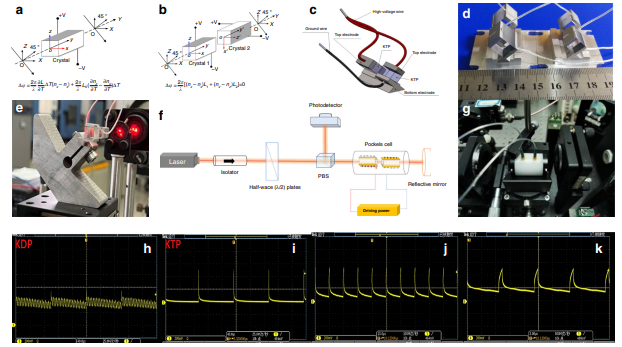
These design features make Raicol’s RTP EO cells highly reliable and efficient for advanced electro-optic applications, ensuring optimal performance in various demanding environments.
Advantages of Raicol's RTP EO Cells
Raicol’s RTP (Rubidium Titanyl Phosphate) EO (Electro-Optic) cells offer several significant advantages for advanced electro-optic applications:
- Fast Operation: These cells provide sub-nanosecond response times, providing rapid operation for high-speed applications.
- Wide Temperature Stability Range: RTP EO cells are designed to operate effectively over a wide temperature range, from -50°C to +70°C, providing reliable performance.
- High Laser-Induced Damage Threshold: They can withstand high laser power densities, with a damage threshold of up to 1 GW/cm² at 1064 nm, making them ideal for high-power laser systems.
- Minimal Ringing: The cells exhibit minimal ringing, which is crucial for maintaining high repetition rates, compatible with over 1 MHz repetition rate.
- Low Half-Wave Voltage: RTP EO cells’ low half-wave voltage allows for a compact design, making them suitable for integration into smaller devices.
- Non-Hygroscopic Nature: RTP crystals are non-hygroscopic, meaning they do not absorb moisture from the air. This property simplifies handling and storage, as no special covers are needed.
- Superior Performance in the 400-3000 nm Spectral Range: RTP EO cells perform exceptionally well across a broad spectral range, making them versatile for various optical applications.
- Low Absorption Losses at 1064 nm: They have very low absorption losses at the common laser wavelength of 1064 nm, leading to efficient operation.
- High Homogeneity: RTP crystals offer high homogeneity, allowing for the production of large cell sizes, up to 15 x 15 mm² as a standard size.
These advantages make Raicol’s RTP EO cells a preferred choice for applications requiring high performance, reliability, and efficiency.
Applications of RTP EO Cells
RTP (Rubidium Titanyl Phosphate) EO cells are flexible components used in various advanced electro-optic applications due to their unique properties.
Here are some key applications:
Q-Switches and Pulse Pickers
RTP EO cells are used in active Q-switches to control the timing of laser pulses, enabling the generation of high-intensity, short-duration laser pulses. They are also used in pulse pickers to select specific pulses from a train of laser pulses, which is essential for applications requiring precise pulse control.
Phase and Amplitude Modulators
RTP EO cells can modulate the phase of a laser beam, which is crucial for applications like laser stabilization, mode-locking and coherent beam combining (CBC). These cells also control the intensity of laser beams, making them suitable for applications in optical communication and signal processing.
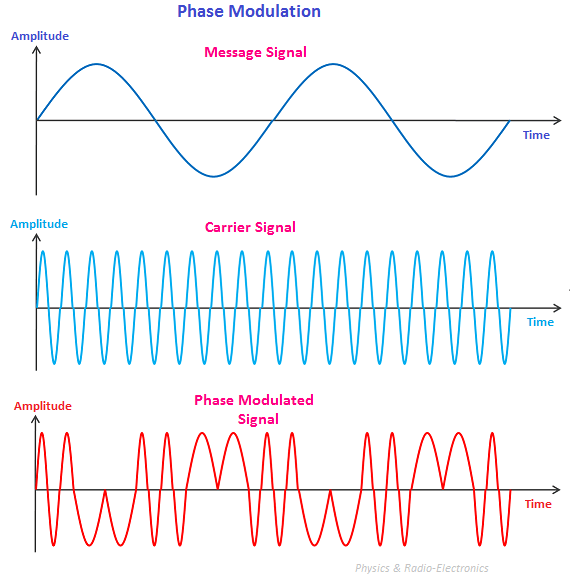
Cavity Dumpers and Shutters
RTP EO cells are used in cavity dumpers to rapidly extract energy from a laser cavity, allowing for the generation of high-energy pulses. They act as fast shutters to quickly block or unblock laser beams, which is important for applications requiring precise control of laser exposure.
Attenuators and Deflectors
RTP EO cells can lower the intensity of laser beams, providing adjustable control over the laser power. They also deflect laser beams, enabling precise beam direction and alignment in various optical systems.
Integrated Quantum Photonics and Quantum Computing [ 2 ]
Some other emerging trends in photonics include integrated quantum photonics and quantum computing, which make use of EO technologies for improved information processing and quantum functionality.
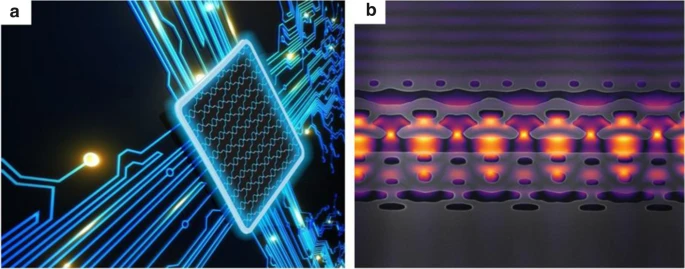
Photonic Integrated Circuits [1]:
Similar to other EO materials RTP can be in a thin film on insulator wafer and enhance performance compared to similar materials. For example, LTOI wafers offer scalable manufacturing at low cost while exhibiting properties similar or superior to lithium niobate-on-insulator (LNOI) wafers. They are used to create high-speed, low-voltage EO modulators and soliton microcombs for high-speed optical communication.
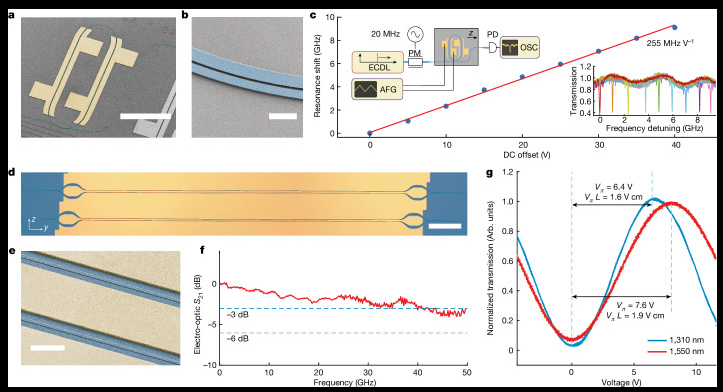
A recent study published in Physics Today [3] discusses the potential of integrating nonlinear optical frequency conversion with EO tunability to improve the performance of integrated photonics. This integration allows for the development of advanced photonic devices that can achieve high-speed data transmission, low power consumption, and enhanced quantum functionality.
Key Findings:
- Nonlinear Optical Frequency Conversion: This technique involves converting the frequency of light to different wavelengths, which is crucial for applications in telecommunications and quantum computing.
- EO Tunability: The ability to tune the optical properties of materials using electrical signals improves the flexibility and functionality of photonic devices.
Raicol’s RTP (Rubidium Titanyl Phosphate) crystals can be integrated into these advanced EO systems to enhance their performance. Here’s how professionals can use Raicol’s materials in light of these new developments:
- In Silicon Photonics:
- High-Speed Modulators: RTP crystals can be used to create high-speed modulators with low half-wave voltage, improving the efficiency and compactness of photonic integrated circuits.
- Increased Data Transmission: The high damage threshold and wide temperature stability range of RTP crystals make them ideal for use in high-power EO modulators, facilitating high-speed data transmission.
- In Nonlinear Optical Devices:
- Frequency Conversion: RTP crystals’ ability to withstand high laser power densities, low absorption losses and high homogeneity makes them suitable for nonlinear optical frequency conversion applications, enhancing the versatility of photonic devices.
- Quantum Computing: Low absorption losses and high repetition rates of RTP crystals can enhance the reliability and speed of devices used in quantum computing.
- In Plasmonic-Organic Hybrid (POH) Devices:
- Ultrafast Modulation: Improve the performance of POH devices, enabling ultrafast modulation speeds.
Due to these properties, RTP crystals are widely used in various electro-optic applications, including Q-Switches, Amplitude and Phase Modulators, Pulse Pickers, and Fast Shutters.
Technical Specifications
RTP (Rubidium Titanyl Phosphate) EO cells are designed to meet the demanding requirements of various electro-optic applications.
Here are some typical specifications:
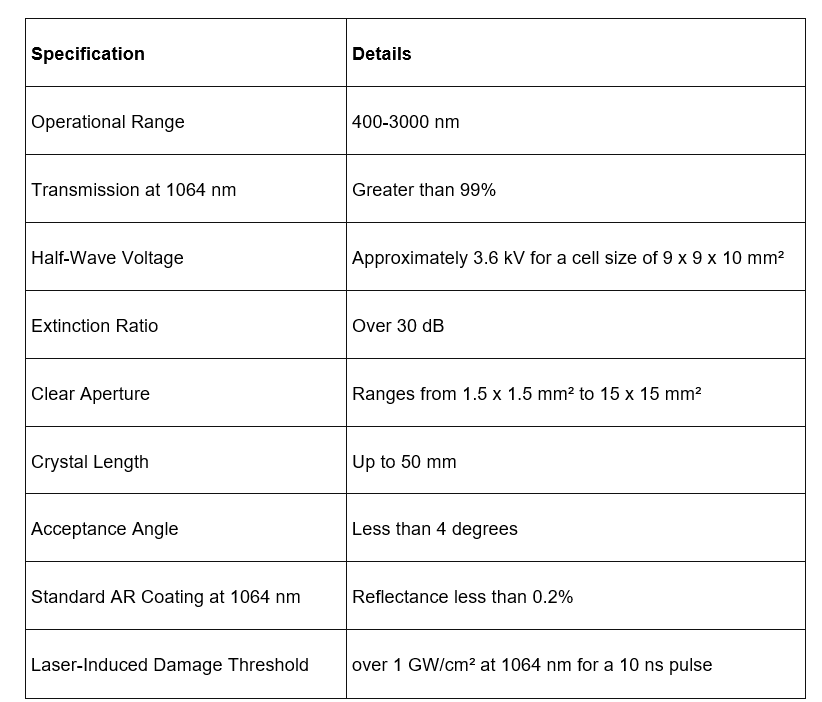
Key Performance Metrics
- Operational Range: RTP EO cells operate effectively across a broad spectral range of 400-3000 nm, making them versatile for various optical applications.
- Transmission: They exhibit high transmission rates, with over 99% transmission at the common laser wavelength of 1064 nm, ensuring efficient light passage.
- Half-Wave Voltage: The low half-wave voltage of around 3.6 kV allows for compact and efficient device designs. Different designs allow to reduce the HWV even more.
- Extinction Ratio: With an extinction ratio of over 30 dB, RTP EO cells provide excellent modulation depth, which is crucial for high-contrast applications.
- Clear Aperture: The large clear aperture options, up to 15 x 15 mm², enable the handling of larger beams and higher power levels.
- Laser-Induced Damage Threshold: The high damage threshold of over 1 GW/cm² at 1064 nm ensures durability and reliability in high-power laser systems1.
- Temperature Stability: Designed to operate over a wide temperature range from -50°C to +70°C, RTP EO cells maintain stable performance in various environmental conditions.
- Low Absorption Losses: Very low absorption losses at 1064 nm enhance the efficiency and performance of the EO cells.
Raicol Crystals’ Expertise and Offerings
Raicol Crystals is renowned for its pioneering work in the development and production of high-quality nonlinear optical crystals, including:
- RTP (Rubidium Titanyl Phosphate): Known for its high damage threshold and excellent electro-optic properties.
- HGTR KTP (High Gray Track Resistant Potassium Titanyl Phosphate): Offers enhanced resistance to grey tracking, making it suitable for high-power applications.
- PPKTP (Periodically Poled Potassium Titanyl Phosphate): Widely used in quantum optics and nonlinear frequency conversion applications.
Complete In-House Production Capabilities
Raicol Crystals has a modern manufacturing facility serves as a one-stop shop for high-quality crystal production. Their in-house capabilities include:
- Crystal Growth: Over 200 crystal growth stations equipped with proprietary growth systems.
- Optical Fabrication: Advanced cutting, polishing machines, and clean rooms ensure precise and high-quality optical components.
- Coating Facilities: In-house AR, DBAR, and BBAR coating capabilities for various wavelengths and applications.
- Testing and Quality Control: Comprehensive testing equipment, including interferometers, spectrophotometers, and laser damage threshold testers, to ensure product reliability and performance.
Flexibility in Production Scale and Fast Delivery Times
Raicol Crystals offers flexibility in production scale, adapting to both mass production and small R&D volumes. Their efficient production processes and extensive experience enable them to provide quick turnaround times to meet customer demands and tailor products to meet specific customer requirements.
These capabilities and offerings make Raicol Crystals a leader in nonlinear optical crystals and electro-optic components, providing reliable and high-performance solutions for various applications.
Conclusion
RTP (Rubidium Titanyl Phosphate) EO (Electro-Optic) cells significantly improve the performance of electro-optic systems by offering superior speed, rates and efficiency. These cells are known for their high damage threshold, ensuring durability and reliability in high-power applications.
Raicol Crystals, a leading provider, offers high-quality RTP EO cells that meet stringent industry and defense standards. Known for innovation and reliability, they serve various industries globally with customized solutions and continuous product improvements through research and development.
References
- Wang, C., et al. (2024). Lithium tantalate photonic integrated circuits for volume manufacturing. Nature, 629, 784–790. Access here
- Chen, Z., Segev, M. Highlighting photonics: looking into the next decade. eLight 1, 2 (2021). https://doi.org/10.1186/s43593-021-00002-y
- 2https://digital.physicstoday.org/physicstoday/august_2023/MobilePagedArticle.action?articleId=1899999#articleId1899999
Do you have a question? Our experts will be happy to hear from you and advise you on the best product for you. Contact Us.
